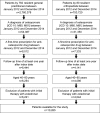Gender- and age-related treatment compliance in patients with osteoporosis in Germany
- PMID: 27920504
- PMCID: PMC5125755
- DOI: 10.2147/PPA.S118396
Gender- and age-related treatment compliance in patients with osteoporosis in Germany
Abstract
Aim: The purpose of this study was to analyze treatment compliance in osteoporotic patients treated with osteoporosis medications in Germany.
Methods: Patients included in the analysis had been diagnosed with osteoporosis with or without fractures and started anti-osteoporotic therapy (bisphosphonates, denosumab, or strontium ranelate) between 2011 and 2014 in a general (GP) or orthopedic practice (OP) setting in Germany. Data pertaining to 6,221 individuals followed in GP and 4,044 individuals followed in OP were analyzed retrospectively. The last follow-up was in December 2015. The main outcome measure was the compliance within the one-year period after the index prescription date. Compliance was measured indirectly and was based on the mean possession ratio (MPR). A multivariate logistic regression model was used to determine the association between MPR (dependent variable) and age, gender, type of practice, type of osteoporosis treatment, therapy frequency, and history of fracture (covariates).
Results: The mean age of the study group was 73.3 years, and 13.2% of subjects were men. Regarding type of practice, 60.6% of individuals were followed in GP and 39.4% in OP. Noncompliance was observed in 55.2% of the patients. Patients in the age group ≤60 years were at a higher risk of being noncompliant when compared to those in the age group of 61-70 years. Men and patients who received oral drugs were also more likely to be noncompliant than women and patients who received injectable or intravenous drugs. Finally, therapies that were given every three or six months were associated with a decrease in the risk of noncompliance when compared to weekly therapy, whereas daily and monthly treatments were associated with an increased risk.
Conclusion: Compliance is insufficient in osteoporotic patients treated with osteoporosis medications.
Keywords: Germany; compliance; fracture; osteoporosis treatment; real-world data.
Conflict of interest statement
The authors report no conflicts of interest in this work.
Figures


References
-
- Facts and Statistics. International Osteoporosis Foundation; [Accessed July 18, 2016]. Available from: https://www.iofbonehealth.org/facts-statistics.
-
- Hadji P, Papaioannou N, Gielen E, et al. Persistence, adherence, and medication-taking behavior in women with postmenopausal osteoporosis receiving denosumab in routine practice in Germany, Austria, Greece, and Belgium: 12-month results from a European non-interventional study. Osteoporos Int. 2015;26(10):2479–2489. - PMC - PubMed
-
- Hadji P, Klein S, Häussler B, et al. The bone evaluation study (BEST): patient care and persistence to treatment of osteoporosis in Germany. Int J Clin Pharmacol Ther. 2013;51(11):868–872. - PubMed
LinkOut - more resources
Full Text Sources
Other Literature Sources
Miscellaneous

